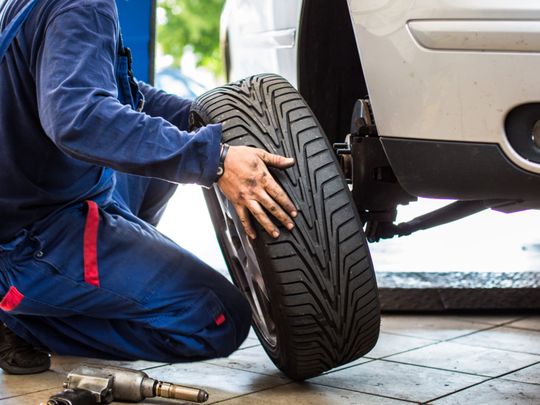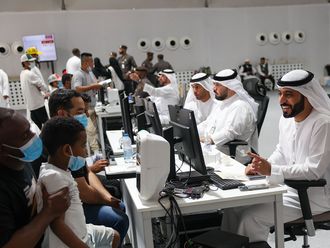
Dubai: Authorities and road safety experts are reminding motorists to check their tyres before we hit the peak of summer, in order to prevent accidents and ensure safety of all road users.
Tyres are the only part of the vehicle that come in direct contact with the road surface. With summer heat sometimes reaching up to 50 degrees Celsius, old and worn-out tyres can burst, leading to horrific road accidents.
Vehicles in the UAE have to deal with harsh climatic conditions, including the hot rays of the sun and regular tyre check is a must. Vehicles using tyres that are more than five years past their date of manufacturing are not allowed on UAE roads, according to Dubai’s Roads and Transport Authority (RTA).
“All tyres must be procured, fitted and maintained properly, considering the taxing climate of the UAE,” noted Thomas Edelmann, founder and managing director of RoadSafetyUAE. He explained to Gulf News: “High temperatures can become a serious problem for tyres, especially if they are not properly maintained. Incorrect pressure, poor wheel balance and faulty alignment also contribute to a reduction in tyre life and safety.”
Edelmann also said: “Tyre debris, mainly from decomposing commercial vehicle tyres, can be seen pretty regularly on UAE roads, and even more during the hot summer months. The number of passenger cars parked on the hard shoulder with tyre defects increases in summer. There is also a high percentage of under-inflated tyres as wells as more wear and tear because of heat. So what is the solution? Educate motorists about the importance of tyre safety and maintenance.”
‘Heat — the enemy of tyres’
Naser Shashaa, regional director of Michelin Middle East Cluster, told Gulf News: Drivers tend to think about their tyres during the rains, when slippery roads require maximum traction. But heat is the enemy of tyres, as some of the most severe tyre-related episodes occur due to under-inflated tyres in summer months. We encourage all drivers to remain vigilant and safe on summer road trips and follow simple summer driving tips such as regular car and tyre check-up. We recommend timely inspection and thorough tyre care in summer as it is essential to ensure safe driving.”
Checklist to stay safe:
> Use only reputable branded and certified tyres. Avoid fitting tyres that may be substandard and therefore potentially unsafe.
> Use the correct tyre type and dimension for your vehicle. Refer to the vehicle owner’s manual or ask for expert advise if not sure.
> Check the tyre pressures at least once a month using a reliable or calibrated gauge. The recommended pressures are quoted in the vehicle owner’s manual or on a sticker usually attached to a door frame or fuel cover. Make sure that the pressures are checked when the tyres are ‘cold’, i.e. driven less than 3km before the check.
> Avoid driving at lower tyre pressure than those recommended by the vehicle manufacturer, because if the tyre/road contact area is altered, it can lead to uneven and/or premature wear, and is likely to adversely affect vehicle handling.
> Inflating tyres with nitrogen instead of air can help maintain pressure stability for longer period.
> It is highly recommended that all four tyres are replaced at the same time, especially on permanent four-wheel drive vehicles to avoid mechanical damage. If only two tyres are replaced on a two-wheel drive vehicle, it is recommended that the new tyres be fitted to the rear axle for vehicle stability and safer handling.
> Front and rear tyres may be permutated (commonly called rotated) every 10,000km or as advised by the vehicle manufacturer, to even out the wear. A wheel balance and alignment check at this time will help the potential life of the tyre to be fully realised, as well as ensure safer driving.
> Respect the load and speed capabilities of the tyres fitted to the vehicle by not exceeding them.
> Avoid driving over or near hazardous objects that could damage the tyres and make them unsafe or unfit for service, for example, rocks, glass, potholes, kerbs etc.
> Check the age of the spare tyre, condition and air pressure to avoid having a spare tyre unfit for use when needed.
> Follow RTA recommendation to replace tyres no later than five years, or earlier if the remaining tread depth is below 1.6mm at any part of the tyre tread band. Tyres must also be replaced if there are other signs of wear or damage, including cracks or cuts in the sidewall or when parts of the tread band are damaged.








